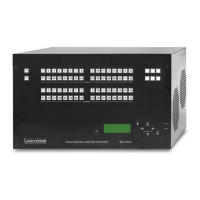4. Operation MX-FR Series Modular Matrix Frames – User's Manual 62
Cong to load item with
the up ▲ and down ▼
with the left ◄ and right ► buttons. Press enter to reload the selected
port parameters, crosspoint presets, EDIDs, etc.) and the previous state
may take several minutes. A status indicator shows the progress. After
matrix reboots.
ATTENTION!
reload process! If the power goes off, then the matrix will restart with
factory default settings.
LCD Menu Pop-up Messages
ALERT Screen
This pop-up screen appears when a high-level error occurs in the matrix.
Press the enter button to dismiss this alert and jump to the system log
entry. Use the up ▲ and down ▼ buttons to scroll between the log entries.
Please contact support@lightware.com.
EDID Mode
To enter or to exit this mode, press and release the EDID button. EDID
mode is active when the EDID button is illuminated on the front panel. All
EDIDs are referred to by their memory location e.g. F49 or D03, see the
EDID Menu section. #edid
Select menu items with the up ▲ and down ▼ buttons and then press
the enter or right ► button to step in submenus. Press the escape • button to return to the main EDID
management menu.
INFO: Not executed operation is canceled when you exit from the EDID menu.
INFO: Source and destination buttons are disabled while EDID mode is active.
Config backup
Save config now!
~Config to load: ~
~< 20160901-1051 >~
Load config file?
NO
~YES >>
Loading - 82%
Don't turn off!
~------------------~
!ALERT! !
!FANSPEED !
~------------------~
Log entries
7/8 Error
FANSPEED
p:0x01 o:3
EDID management
~View EDID >>
Save EDID
Switch EDID
View EDID Menu
All the stored EDIDs can be checked through this menu. The EDID types
are grouped in submenus.
The most important information about each EDID is shown in the submenu.
Use the left ◄ and right ► buttons to select the desired EDID. The monitor
name and the preferred resolution can be checked.
Save EDID Menu
The EDID from any connected monitor can be saved to user memory slots.
Select the dynamic EDID of the output port with the left ◄ and right ►
buttons. Then press down ▼ and select the user EDID slot where the
After the desired dynamic EDID and user memory is selected, go to Save!
and press the enter or right ► button to store the EDID.
Switch EDID Menu
The emulated EDIDs can be changed in this menu. Dynamic, User or
Factory EDIDs can be selected in the top row with the left ◄ and right ►
buttons. The preferred resolution of the selected EDID is shown in the
second row of the screen.
Press down ▼ and then select the input port with the left ◄ and right ►
buttons.
After the desired EDID and input port is selected, go to Do switch! and
press the enter or right ► button to change the emulated EDID.
The Operation in progress message appears on the LCD. If switching the
EDID succeeds, then the Operation done! message is shown for 2 seconds.
Signal Present Mode
Press the Signal present button to enter or exit this mode. The Signal present
mode is active when the button is illuminated.
In this mode the source and destination buttons show the actual connection state of the
corresponding port, and the actual crosspoint state can be checked on the LCD menu.
Press the up ▲ or down ▼ buttons to navigate between the submenus and screens.
ATTENTION! Source and destination buttons are disabled while Signal Present mode is active.
View EDID
~Dynamic EDIDs >>
Emulated EDIDs
Factory EDIDs
Dynamic EDIDs
<EDID mem: D15 >
PHL Philips 230W5
1920x1200@59.94Hz
EDID Save
<Dynamic EDID D6 >
to User EDID U2
Save!
EDID Save
Dynamic EDID D6
to User EDID U2
~Save! >>
<Switch EDID: F21 >
LWR D1600x1200p60
to input: 4
Do switch!
Switch EDID: F21
LWR D1600x1200p60
to input: 4
~Do switch! >>

